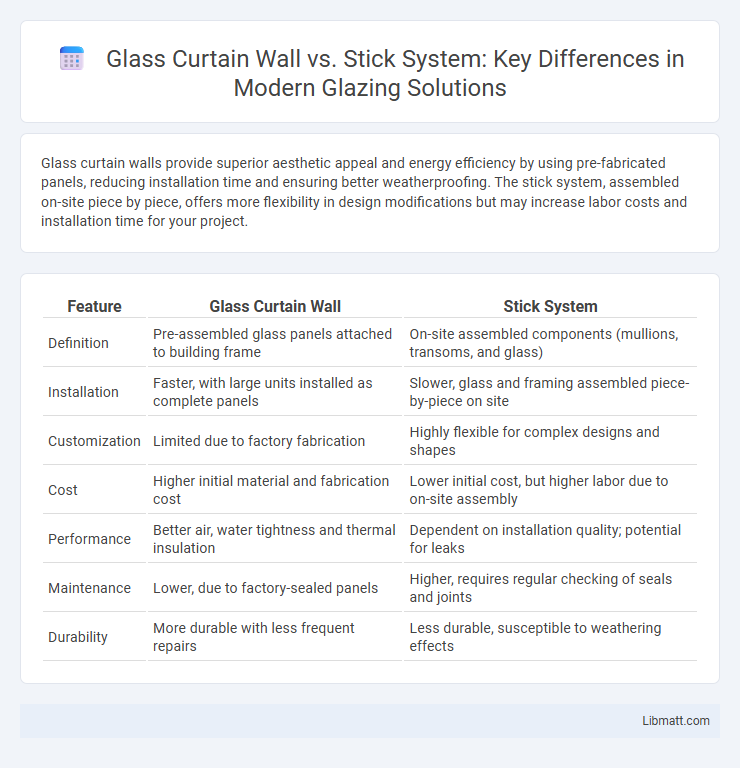Glass curtain walls provide superior aesthetic appeal and energy efficiency by using pre-fabricated panels, reducing installation time and ensuring better weatherproofing. The stick system, assembled on-site piece by piece, offers more flexibility in design modifications but may increase labor costs and installation time for your project.
Table of Comparison
| Feature | Glass Curtain Wall | Stick System |
|---|---|---|
| Definition | Pre-assembled glass panels attached to building frame | On-site assembled components (mullions, transoms, and glass) |
| Installation | Faster, with large units installed as complete panels | Slower, glass and framing assembled piece-by-piece on site |
| Customization | Limited due to factory fabrication | Highly flexible for complex designs and shapes |
| Cost | Higher initial material and fabrication cost | Lower initial cost, but higher labor due to on-site assembly |
| Performance | Better air, water tightness and thermal insulation | Dependent on installation quality; potential for leaks |
| Maintenance | Lower, due to factory-sealed panels | Higher, requires regular checking of seals and joints |
| Durability | More durable with less frequent repairs | Less durable, susceptible to weathering effects |
Introduction to Glass Curtain Wall and Stick System
Glass curtain wall and stick system are two widely used facade construction methods in modern architecture, each offering unique structural and aesthetic benefits. Glass curtain walls consist of prefabricated glass panels mounted onto a building's framework, providing a sleek and seamless exterior with high thermal performance. The stick system involves assembling mullions and transoms on-site, allowing for flexible design and easier customization to suit your building's specific requirements.
Key Differences Between Glass Curtain Wall and Stick System
Glass curtain walls are prefabricated panels made of large glass sheets installed as a complete unit, offering superior thermal performance and airtightness. Stick systems involve assembling individual glass components and framing on-site, providing more flexibility for customization and easier maintenance. Your choice depends on project scale, budget, and desired aesthetic, as curtain walls deliver faster installation, while stick systems allow for detailed adjustments during construction.
Design Flexibility and Architectural Impact
Glass curtain wall systems offer superior design flexibility by enabling expansive, uninterrupted glass surfaces that enhance natural light infiltration and create sleek, modern aesthetics. Stick systems, composed of individual mullions and glass panels assembled on-site, provide modular adaptability for varied facade patterns but may limit seamless visual continuity. The choice between glass curtain walls and stick systems significantly impacts architectural expression, with curtain walls promoting minimalist, high-performance envelopes and stick systems facilitating incremental customization and easier maintenance.
Structural Performance Comparison
Glass curtain walls provide superior structural performance due to their prefabricated panels, which offer enhanced rigidity and resistance to wind loads compared to stick systems. Stick systems involve on-site assembly of individual components, resulting in more joints and potential points of weakness under structural stress. Your choice between these systems affects building durability, energy efficiency, and maintenance requirements, with glass curtain walls generally delivering higher performance in demanding architectural projects.
Installation Process and Construction Time
The glass curtain wall installation involves prefabricated panels that are lifted and secured to the building frame, significantly reducing on-site labor and accelerating construction time. Stick systems require assembling mullions and glass panes piece by piece directly on-site, which extends the installation duration due to its labor-intensive nature. You can achieve faster project completion with curtain walls because their modular components allow for streamlined, efficient installation compared to the more incremental stick system process.
Energy Efficiency and Thermal Performance
Glass curtain walls provide superior energy efficiency by incorporating high-performance glazing and thermal breaks that minimize heat transfer and improve insulation. Stick systems, while flexible and cost-effective, often have more thermal bridging due to their exposed framing, which can reduce overall thermal performance. You can maximize your building's energy savings by selecting glass curtain walls with advanced glazing technologies designed to optimize thermal insulation and reduce energy consumption.
Cost Considerations and Budgeting
Glass curtain walls typically involve higher upfront costs due to factory-fabricated panels and complex installation, impacting your overall project budget significantly. Stick systems offer a more cost-effective alternative with on-site assembly and greater flexibility for adjustments, reducing labor expenses and material waste. Careful evaluation of life-cycle costs and maintenance requirements is essential for accurate budgeting between the two options.
Maintenance Requirements and Longevity
Glass curtain walls demand regular cleaning and inspection to maintain their aesthetic appeal and prevent sealant deterioration, while stick systems often require more frequent maintenance due to their numerous individual components prone to wear. The longevity of glass curtain walls typically surpasses stick systems thanks to their integrated design, which reduces the risk of water infiltration and structural fatigue. Choosing the right system for your building impacts long-term maintenance costs and overall durability.
Suitability for Different Building Types
Glass curtain walls offer high aesthetic appeal and are ideal for high-rise commercial buildings where sleek, uninterrupted facades are desired, providing superior thermal and acoustic insulation. The stick system is more suitable for mid-rise or low-rise structures, including residential and smaller office buildings, offering flexible installation and easier integration with diverse architectural styles. Both systems cater to different structural and design needs, influencing the choice based on building height, complexity, and budget considerations.
Choosing the Right System for Your Project
Selecting the appropriate glass curtain wall or stick system depends on factors such as building height, budget, and aesthetic goals. Glass curtain walls offer superior thermal performance and sleek, uninterrupted exterior views, ideal for high-rise projects emphasizing energy efficiency. Stick systems provide flexibility with easy installation and maintenance, making them cost-effective for low- to mid-rise buildings requiring custom design solutions.
Glass curtain wall vs stick system Infographic

 libmatt.com
libmatt.com